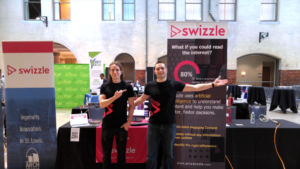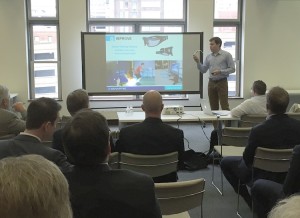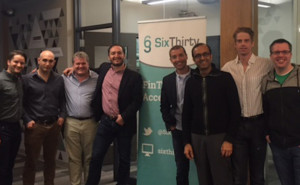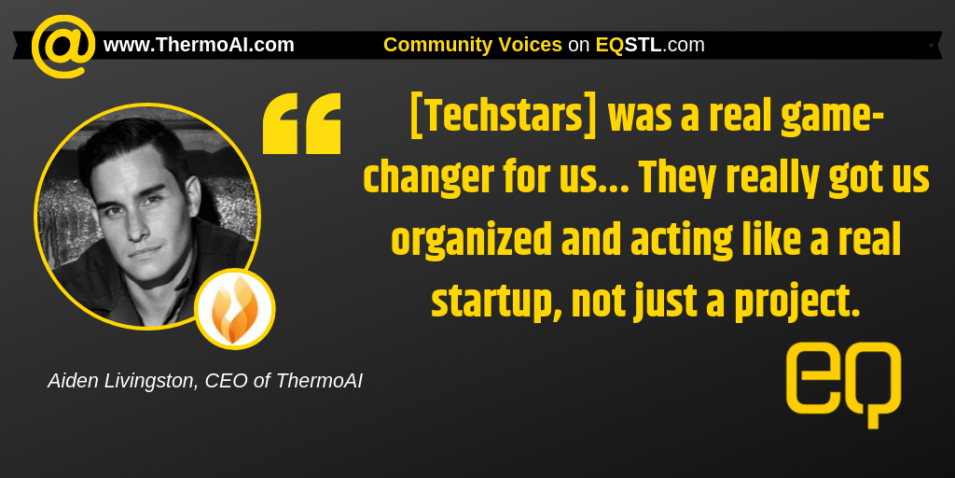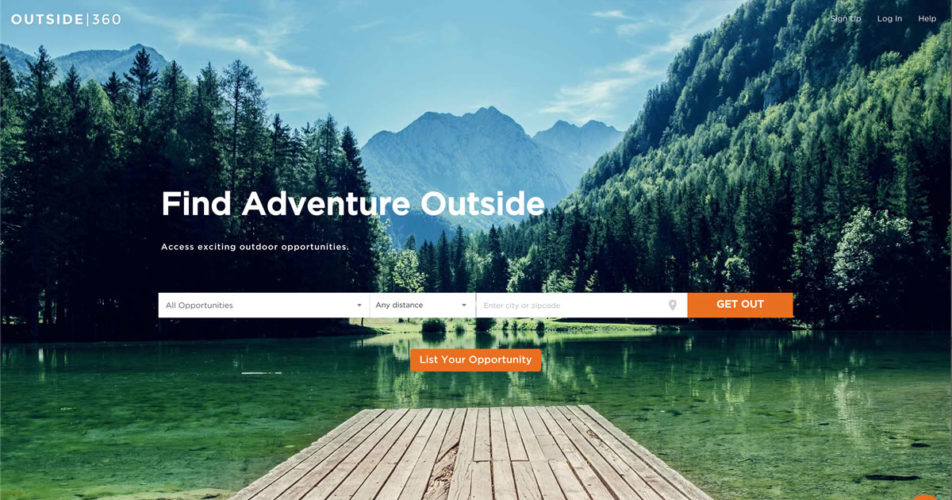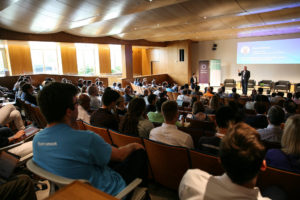
Two SixThirty Startups Raise $25 Million in Funding
- Atul Kamra, managing partner of the global FinTech venture fund SixThirty, refers to St. Louis as “the third coast of FinTech innovation.”
-
He’s not talking about the banks of the Mississippi River, but St Louis’ massive financial services hub.
-
The city boasts the highest density of investment advisors behind Boston and New York and the largest center of financial services firms outside Manhattan.
-
SixThirty’s investment profile includes an annual Spring Program where FinTech startup founders can raise up to $250,000 for their venture and participate in an eight-week mentorship and go-to-market regimen.
-
The program aims to validate each startup’s product-market fit, accelerate relationships with potential clients and channel partners, andscale revenue growth in the U.S. market.
-
The Spring Program focuses on ‘later-than-early’ stage startups: companies that have a working product, market traction, and early revenue in the B2B market, and that are ready to refine and “battle-test” their go-to-market strategy.
-
“FinTech startups go to San Francisco to find capital,” says Kamra. “They come to St. Louis to find revenue.”
2017 saw two SixThirty portfolio companies raise significant investment. Both companies are based in Israel and came to St Louis to work with SixThirty and its corporate partners.
The trip must have been worth it for the founders: the two fintech startups — BondIT and PayKey — raised $14.25M and $10M respectively.
On their participation in the program, PayKey told EQ, “The SixThirty team provided us with much-needed tools and knowledge to help us improve our go-to-market strategy in the US. The engagements and partnerships that were created have helped us successfully reach the goals that we set for ourselves when coming into St. Louis.”
What Does SixThirty Do?
Fintech startup founders looking to join SixThirty’s Spring Program in 2018 can expect to raise up to $250,000 in funding for their venture and participate in SixThirty’s 8-week mentorship and go-to-market program. The program aims to do three things:
- Validate the startup’s product-market fit
- Accelerate relationships with potential clients and channel partners
- Scale revenue growth in the US market
The program’s primary focus is on ‘later-than-early’ stage startups: companies that have a working product, market traction, and early revenue in the B2B market and that are ready to refine and “battle-test” their go-to-market strategy.
Bringing Innovation to Institutions
Launching a successful financial technology product takes more than funding and a good idea.
Fintech founders face complex institutional and regulatory hurdles: they may need money transfer, banking, trading or commodities licenses.
More than that, successful product-market fit depends on close alignment with the needs and operating practices of major financial institutions.
Fintech startups often face a Catch 22: institutions don’t want to open their doors to startups with an unproven product, and startups can’t prove (let alone improve) their product without embedding themselves in larger institutions.
SixThirty tackles the built-in complexity of fintech innovation by investing in the process of product-market validation, while traditional investors would expect this milestone to be passed long before they get involved.
The Third Coast Of Fintech Innovation
Atul Kamra, Managing Partner of SixThirty, calls St. Louis “The Third Coast of FinTech innovation.”
That’s not just a joke about St. Louis’ spot on the banks of the Mississippi — it’s a strong reminder of the city’s provenance as a massive financial services hub.
St. Louis has the highest density of investment advisors outside of Boston and New York City. In a recent article, the Economist also named St. Louis the largest center of financial services firms outside of Manhattan.
So SixThirty’s choice of place is no accident: during the process of product-market validation, the program gives entrepreneurs a direct line into the financial ecosystem. Founders can expect meetings with the likes of State Farm, UMB, Edward Jones, Worldwide Technology and the Reinsurance Group of America — to name but a few.
Since most SixThirty companies enter the program with well-developed products, relationships with institutions help them fast-track the path to revenue.
“Fintech startups go to San Francisco to find capital. They come to St. Louis to find revenue,” Kamra quipped during a presentation at the 2017 Inside/Outside Innovation Summit.
A “Startup Collider” Model
SixThirty is sometimes referred to as a startup accelerator. The program’s leaders reject the label, as an empty catch-all term for programs serving early-stage ideas.
Personally, I think of SixThirty as a Startup Collider. A particle accelerator collides molecules into each other to see what new discoveries can be made in quantum physics — from bonds to reactions to vacuums and even basic gaps in our knowledge of how to measure these effects.
SixThirty “collides” fintech startups into enterprise companies, to see what opportunities and partnerships emerge.
Through direct introductions to leading enterprise organizations — who could be the next buyer or partner for a startup’s product — SixThirty initiates a critical customer engagement process. That process acts like a crucible for a chemical reaction between your idea and the larger needs of the market.
Hidden In Plain Sight
Naturally, it’s impossible to know exactly what will emerge from the collision of a fintech startup and financial enterprise.
But SixThirty’s investment thesis contains a set of guiding principles for placing strong bets: according to Kamra, the best opportunities are “hidden in plain sight.”
Presenting at the Inside/Outside Innovation Summit 2017, Kamra explained that the attitude towards innovation is shifting from one of disruption to collaboration.
Following the tidal wave of new technologies has been an increasing technical literacy in the market. Buyer questions have evolved from “What can this technology do?” to “Why do I need this technology to do that?”
The answer may not be as apparent as startup founders may like to think. Disruptive technologies carry many implications for evolution of the financial services industry, but the specific applications and use cases are not always self-evident.
Kamra argues that most startups succeed at the point where they identify friction in the industry. Those points of friction carry hidden costs. And targeting those hidden costs are the phenomenally disruptive opportunities that lie hidden in plain sight.
“Zara, the clothing brand, is a canonical example,” he explained. Zara identified that markdowns – discounts and sales – are the biggest cost in the apparel industry — but they don’t show up anywhere on a traditional profit and loss statement.
Prior to Zara, the fashion industry was all about predicting demand, with lead times of 9 to 12 months, or more, between fashion runways and products appearing in stores. But it turns out that customers are fickle and predicting demand is very, very hard to do: for the most part, fashion companies were terrible at it. Huge losses from markdowns were accepted as a basic cost of doing business, instead of as a problem to fix.
Zara challenged this way of thinking by radically reducing the time between designing, producing and shipping new designs.
They accelerated traditional seasonal fashion cycles, re-tooled the supply chain and information systems to rapidly adjust production and inventory in response to customer reaction and shifted customer behavior from deferral towards urgency.
Eager buyers had to respond to scarcity rather than wait for discount sales. The biggest cost to the business was reduced — while demand increased.
Finding the Hidden Costs in Fintech
For Kamra and SixThirty, collaboration precedes disruption.
Zara’s greatest innovation wasn’t in its products, it was in how the company rethought basic principles for bringing those products to its customers.
The same principle applies in fintech.
A new software product may take only $1M to develop or license. But for an incumbent to adopt the product, they may still need to spend $4M to train their employees to use it and another $3.5M to integrate the new codebase with their legacy systems. Hidden costs escalate quickly.
With that principle in mind, Kamra urges startup founders to pursue what he calls “unsexy problems” when approaching incumbent financial services institutions:
“The unsexy part of what needs to get done is where the value is actually captured or lost. If by the second meeting, you’re not having a conversation about integration — what are the barriers for someone to adopt your product? — then the third meeting is going to be a waste.”
Zara’s true innovation wasn’t in products, but in process, to overcome a point of market friction. Similarly, Kamra contends that real change in the finance industry doesn’t come from “shiny objects” — new tech products and platforms — but from overcoming breakpoints in the industry around human behavior and data.
“Most of the real costs in executing are around integrating, reconciliation and training. Not the new solution or code. They are hidden in plain sight — nowhere to be seen in a traditional profit and loss statement. The hidden costs are also generally correlated with solutions that are not well designed or implementations that are not fully thought through. Not addressing them will ultimately diffuse the impact of the innovation and slow the time-to-market. The entrepreneur’s role is to pinpoint and address the real costs, empathize with the buyer and stand out against folks trying to simply sell the shiny object.”
Matching Experience and Innovation
Such experiences are why SixThirty moved from being a straightforward venture capital fund to a startup collider – an innovation platform that infuses capital into promising startups looking to connect with large corporations.
SixThirty can pair high potential talent with the curiosity and market intelligence needs of the nation’s major firms all under one program.
“The experience that corporate leaders bring is really important. These are mature folks, they know the context and operating environment – the technology, regulations, existing vendors, decision-makers – surrounding an innovative solution.”
“To work with an entrepreneur on a weekly basis, absorb the innovation, work with their peers in the industry — it allows the investigative process to thrive. Our approach is to fundamentally challenge points of friction, in a setting that is good for both the entrepreneurs and the shareholders of leading financial services players.”
What Does That Mean For 2018 Applicants?
Colliding your product offering with the market means it will go through rigorous testing and refining, so much so, that founders need stamina to engage with the strategy. That’s true of any startup, fintech or otherwise.
The end result may not be identical to the idea you started with, but it’s exactly that outcome which SixThirty invites founders to consider.
It’s like applied science. Theory becomes a lot more valuable to everyone when it can be applied to a specific use case.
And the proof is in the pudding. BondIT, a SixThirty portfolio company, raised over $14 million last year. And PayKey raised $10 million.
What Was The Experience of Last Year’s Portfolio Companies?
“SixThirty was, for me, an eye-opener for the US Market. The mentors we received through SixThirty helped us gain access to the most strategic players in the US,” Etai Ravid, CEO and Co-Founder of BondIT told EQ.
What’s especially exciting about their traction is that the BondIT teams were not natural-born fixed income asset traders. BondIT’s Co-Founder and Chief Scientist, Dr. Hillel Raz, PhD, is primarily an expert in machine learning.
“We saw an opportunity to match smart algorithms, data, and fixed income into an easy-to-use platform. The structure of the Israeli Market has several very useful attributes to get us started (fully electronic and with small lots). So it was cheap for us to buy market data and check the concept quickly on the local market. And it was also the beginning of the robo movement so everything was ready for the perfect storm.”
BondIT plans to use the $14.25M invested by Fosun to expand on two fronts: deeper into the U.S., the world’s largest market; and outward, to gain a foothold in China, the world’s third-largest but fastest-growing.
“Fixed income is by far the largest asset class globally,” Kamra told EQ, reflecting on BondIT’s success. “BondIT makes it really transparent and simple to construct a fixed income portfolio, condensing the process from hours and days, into minutes or seconds. It’s in the data and the design: in how the UI is intuitive, in how it integrates into data systems to access information and how it connects to the bond markets. It’s simple, integrated and connected… So it gains adoption, improves advice experience and advice quality.”
Kamra recalls demonstrating BondIT to a Finance Professor at Washington University, who remarked, ‘How come nobody has created this in the past?’
“That’s the kind of investment we look for. Opportunities of a global scale that are hiding in plain sight. BondIT is at the heart of SixThirty’s investment thesis.”
Remarkably, for the financial services industry, it took founders who were not natively ‘in’ the fixed income market to come up with a solution that was transformative. It was only after the fact that BondIT and SixThirty brought in fixed-income experts to help with adoption, industry practices and defining a path to market.
“SixThirty is a natural ‘marketplace’ to test an idea like that,” Kamra continued. “We can mature the product, but also to grow the product base. Our platform offers an interesting proposition from both a validation and mentorship standpoint, and from a commercialization standpoint.”

